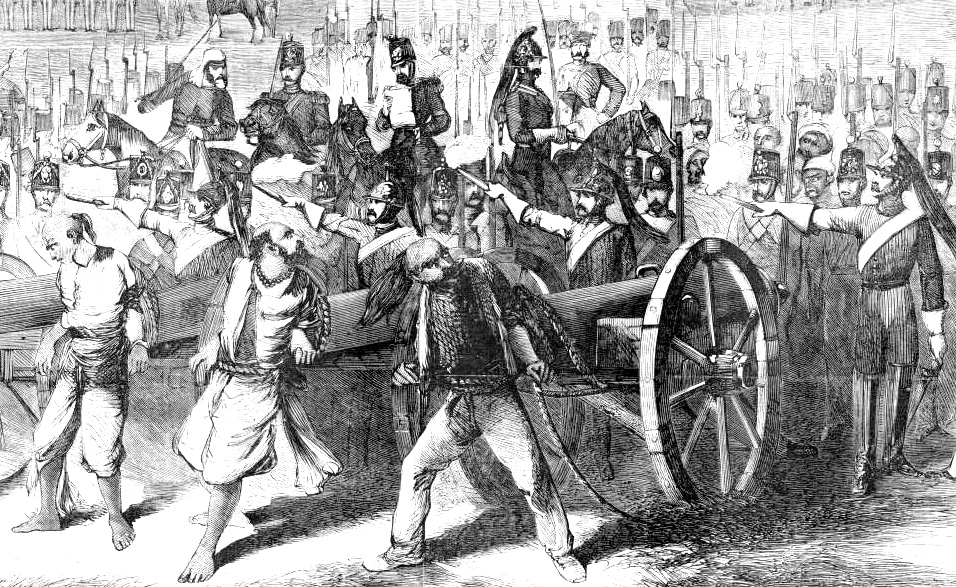Execution by Cannon, 1857
Printed From: History Community ~ All Empires
Category: Regional History or Period History
Forum Name: History of the South Asian subcontinent
Forum Discription: The Indian sub-continent and South Central Asia
URL: http://www.allempires.com/forum/forum_posts.asp?TID=32628
Printed Date: 21-May-2024 at 00:01
Software Version: Web Wiz Forums 9.56a - http://www.webwizforums.com
Topic: Execution by Cannon, 1857
Posted By: Salah ad-Din
Subject: Execution by Cannon, 1857
Date Posted: 06-Nov-2012 at 15:36
|
In June of 1857, much of the Bengal Army was in revolt against the British, caught up in the vast (if often misinterpreted) Indian Mutiny. At this time, Brigadier General Neville Chamberlain was in command of a 'movable column' striking out at the mutineers, and was currently staying in Lahore.
During the night a loyal sepoy belonging to the 35th Bengal Native Infantry Regiment informed Chamberlain's young staff officer Frederick Roberts that the Regiment was planning to mutiny, and some men were already preparing their weapons for a late-night attack on their unsuspecting British comrades. Roberts woke Chamberlain who had the regiment muster on the parade ground, and during the subsequent inspection two would-be mutineers were discovered with their muskets already loaded in anticipation of the fighting to come. These two luckless sepoys were court-martialed and sentenced to death. Under normal circumstances, military executions were carried out via hanging. However, given the remarkable and particularly dreadful circumstances surrounding the Mutiny, as well as the atrocities many of its participants were committing, a more spectacular departure from this life was chosen for the prisoners. In previous centuries the Mughal rulers of India had executed some of the worst criminals by tying them with their backs facing the muzzle of a cannon, which was subsequently fired, blowing the condemned to bits and splattering all those around with his blood and blackened body parts. Though some criticized it as being a brutal and 'un-Christian' method of execution, the British officers tasked with putting down the mutiny felt it would send a powerful message to other would-be troublemakers. Frederick Roberts described what took place the day after the sentence was issued. The 35th Infantry again formed up on the parade ground with three sides of a square - the fourth side consisted of two cannon facing outside the square. As the condemned were led onto the parade ground one asked Roberts if they were going to be 'blown from guns' and Roberts solemnly answered affirmatively. Only when they had been bound to the cannons did one of the sepoys speak again, making a futile petition to have some rupees sent to his bereaved family. Chamberlain proclaimed "it is too late!" thus sending the message that no luxuries would be left to those tainted by the spirit of mutiny. Both cannon were subsequently fired, and the parade-ground was sprayed with fragmented pieces of bones and innards. The Indian Mutiny was put down with a vengeance, particularly after the vicious murder of European women and children at Kanpur became common knowledge. Before it was over the British and their remaining Indian allies had committed at least as many fearful massacres as the mutineers, who invariably came to a poor end. Many regiments were disbanded, while those few mutineers who eluded British justice now faced a less lucrative existence as members of a robber-gang. Hundreds more were executed - some by hanging, others (especially those implicated in the deaths of European women) by cannon. |
Replies:
Posted By: Nick1986
Date Posted: 07-Nov-2012 at 08:33
|
The Iranians also executed criminals with cannons. Without a complete body, it was beleived their souls could not enter paradise
------------- Me Grimlock not nice Dino! Me bash brains! |
Posted By: Azita
Date Posted: 08-Nov-2012 at 04:58
|
The Indian mutiny certainly scared the British, resulting in quite harsh reprisals. When one reads of the butchery inflicted on the British civilians , especially the quite literal butchery at Cawnpore, i suppose given the mortality of the time, the executions were understandable. The method was somewhat extreme, a more human way would be to put a wet sponge on a persons head and pass a huge electric current through the victims head....... Out of interest what is current thinking on the actual cause of the mutiny, cartridge grease? I did read that the Russians circulated this misinformation, and that the grease was not pig/cow. Azita |
Posted By: Nick1986
Date Posted: 10-Nov-2012 at 11:59
Cartridge grease was just the spark of the mutiny. It had many underlying causes, including relgious tensions, brutal army punishments, and resentment from Muslim lords of their British masters ------------- Me Grimlock not nice Dino! Me bash brains! |
Posted By: Nick1986
Date Posted: 19-Dec-2012 at 12:54
 ------------- Me Grimlock not nice Dino! Me bash brains! |